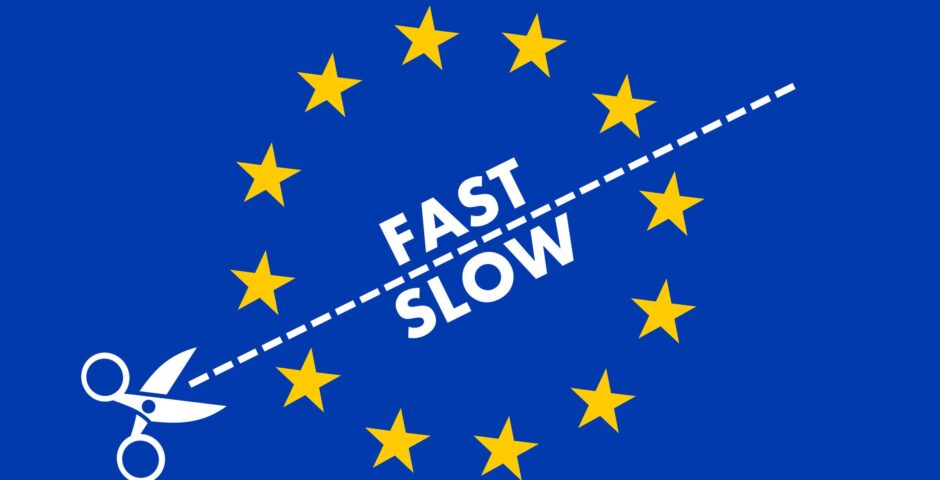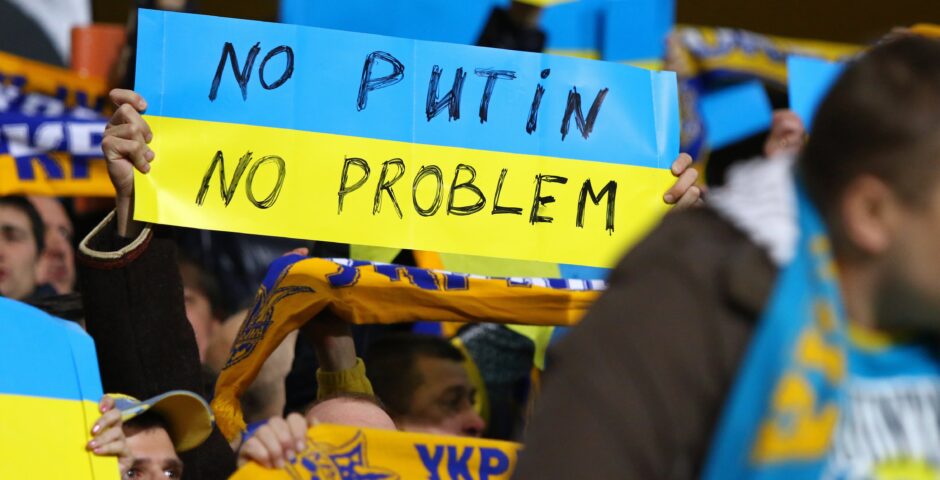European integration in multiple speeds

Motives for a multi-speed Europe.
The deadlock of unanimity
The European Union is a vastly complex international organisation in which every decision needs to be checked by a variety of institutions before it can be implemented and maintained by the member states (MS). Of these institutions, the European Council, the European Parliament and the European Commission are the most important. Out of these three, the European Council is the most powerful, consisting of the government leaders and heads of states of the 27 MS. However, the council is also one of the most constrained institutions, due to constraints inherent to structure. This is namely caused by the wide variety of interests and opinions represented in this institution. However, what remains irrefragable is that the Council (meaning the MS) have the strongest voice in determining the course of the EU. Hence, the intergovernmental nature of the EU is stronger than its supranational nature. Still and all, decision making remains an arduous undertaking when 27 different negotiators have to reach a common consensus
As the enlargement of the EU continued, the Lisbon Treaty of 2007 altered the manner of decision making which shifted from unanimity to qualified majority voting (QMV). This entails that a minimum of 55% of the MS – meaning a minimum of 15 out of the 27 – have to vote in favour. These MS have to simultaneously represent at least 65% of the total EU population. Unfortunately, this development did not mean a change to the fact that the Council is filled with ever existing contradicting national interests of the individual MS. In addition, the larger and course-altering decisions and treaties are still solely agreed upon through unanimity in the EU. Even if there is room for taking a decision through QMV, the MS almost reflexively seek consensus as to not antagonise those MS who do not agree. The origin of this tendency lies in the nature of the negotiations in the EU, namely that they never stop since there are always problems and issues that need to be sorted out. This refers to the aspect of the EU that MS are bound to each other in the long term and need to maintain good working relations with one another. Thus, instead of pushing through a decision with QMV despite severe opposition, it is often prefered to seek consensus as to not harm the internal relations between the MS in the long run which could negatively impact the functioning of the EU as a whole. The downside of this instinctive safety mechanism is that the tendency towards consensus slows down decision making and could lead to half-hearted and watered-down policies as a result from compensating everyone’s preferences. In short, the danger of inadequate policy is present.
An often mentioned and extensively analysed solution could be to give more freedom to the MS to form coalitions on certain policy terrains. Meaning, to give the MS room to move further ahead and cooperate in smaller groups on shared policy interests rather than engaging with the EU as a whole . This would give countries who see benefits in furthering integration the possibility to do so, unhindered by those more retentive states who are not yet willing to integrate deeper. This can manifest itself as groups of countries who, for example, want to cooperate more on defence, energy or healthcare issues. The underlying theoretical principle is called a ‘multi-speed Europe’. What this is and how it could potentially function in reality will become clear in the remainder of this article.
Revolutionary breakthrough or old ideas in a new guise?
The idea of a Europe that integrates at different speeds is a theme that has enjoyed some scholarly attention. It is not new and has already been applied in Europe. A clear example is the Eurozone, referring to the 19 countries within the EU27 that are using the Euro as their national currency. Consequently, there are still 8 countries who are not (yet) using the Euro. The theoretical understanding underlying this is elaborated upon by Professor Vivien Schmidt of Boston University in her work Re-envisioning the European Union from 2009. She explains how the constant quest for unanimity is creating a de facto mutual hostage situation, in which a few member states are capable of blocking or weakening important developments and legislation, even if there is wide support amongst the other MS. This phenomenon can easily be seen as troublesome for current and future European cooperation. When decision making is hampered by the sheer variety of national interests combined with the existing tendency to seek consensus, ineffective policy and a consequent standstill is the outcome. When this occurs, the discontentment concerning the EU will increase which harms its political legitimacy. Therefore, it would be no understatement to conclude that this is a fundamental threat to the Union.
In its essence, this situation is being caused by one of the core conceptions of the EU, namely that integration must occur in harmony. This principle has been central since the early days of European integration. A multi-speed Europe can be placed opposite this conception and could therefore serve as a solution to the aforementioned problem in the policy-making process since it diminishes the role of unanimity in decision making. This may drive MS towards letting go of the ‘integration in unity’ conception, motivated by the potential room it leaves for asymmetrical steps towards integration . When put in practice, a multi-speed Europe can crystallise in two ways. On the one hand, groups of countries can pull together in certain policy areas and strive for more integration/cooperation in the area through coalitions of the willing. On the other hand, groups of countries can choose to step on the break for certain developments and not partake or join in later.
Solving the consensus problem in this manner will go hand in hand with accepting that the well-known EU-adage ‘unity in uniformity’ will be discarded, with a shift towards integration that will not be simultaneous across the whole Union (called differentiated integration). This would not be as revolutionary as it might seem. Instead, it would be a deepening of the opt-out principle, an already existing mechanism in the EU. Opt-outs in simple terms means having an exception position in certain agreements, which can be stipulated during negotiations. An earlier mentioned example is that of the Eurozone, in which Denmark and the United Kingdom have negotiated an opt-out, which entails that these countries are permanently cleared of the obligation to implement the Euro. Something that for example is not the case for the other MS who have not yet implemented the Euro as their currency. Needless to say, Denmark is, as of Brexit, the only MS that has this opt-out position. A second example is the Schengen Area, on which Ireland holds several opt-outs. Accordingly, a multi-speed Europe would mean a widening of the opt-out mechanism with the addition of being able to not only move further ahead in coalitions but also to take a step back.
Likely consequences
There are multiple pros and cons when a multi-speed Europe were to manifest in Brussels. The most obvious pro, based on this article, would be that it would solve the occurring stalemate in the European Council: unanimity would stop being a killjoy. Furthermore, it could have a positive impact on the effectiveness of European policy since more like-minded countries would be cooperating. Moreover, it could increase the legitimacy of the EU since expectations and reality will be more aligned. The main reason for this being that citizens who voted for less European integration will not be confronted with more EU regulations and integration as the MS have more. The reverse also holds true: predominantly pro-European electorates are more likely to experience policies furthering EU integration when their country joins such a coalition of the willing.
Concerning the cons, the most noteworthy is that forming coalitions and integrating at different levels could cause severe fragmentation, which could dramatically weaken the EU. The amount of freedom that the MS would gain in forming coalitions in certain areas must be adequately controlled so as to not jeopardise the EU itself. Moreover, this aspect is of great importance to make sure that MS will not start questioning already existing structures and legislation. Another downside is that the democratic deficit will increase in the EU, since it will be more difficult for major institutions such as the European Commission and especially the elected European Parliament to fulfil their controlling function. MS making agreements between themselves could potentially undermine EU institutions in their functioning. Lastly, there is a rather practical downside. The EU will become more complicated, which will only increase the already existing distance between Europe and its citizens since it will be more difficult to understand the functioning of the institutions. The cause is rather simple: the overview of the Union becomes harder to maintain with several coalitions who all have their own sets of agreements, rules and plans.
A prayer without an end
If a Europe of multiple speeds will eventually become reality depends completely on the politicians who we elect to represent us in the EU. Despite the multi-speed theory being addressed quite often in the academic world, it lacks attention from the political realm. Only recently, before the general Dutch elections of March 2021, the Christian democratic party (CDA) somewhat included it into their election programme. They argued that the EU could become stronger through small bundles of MS who could then function as leading countries. However, it is unclear whether the party meant such a working method as laid out in this article. Besides this small example, which received little to no attention in the campaign, the multi-speed theory remained underexposed in the latest election round.
Even if there would be more attention for this topic in politics and the MS would seek to establish a Europe of multiple speeds, it would only be attainable through a change in the founding treaties of the EU. Treaty change is something that Donald Tusk, former president of the European Council, once described as opening Pandora’s box. Not a light analogy, but very accurate since it is a typical example of the problem that this article started with. Namely, the almost impossible task of reaching unanimous decisions/treaties amongst 27 MS. In the case that such a treaty which included the multi-speed theory were to be signed, it would truly be a “treaty that would end all treaties”, as Professor Vivien Schmidt called it.
For the time being, it does not seem likely that treaty negotiations will be commenced in the near future. Thus, the Treaty of Lisbon remains the most recent achievement in this area. On the other hand, the current corona crisis could provide for an ample catalyser in triggering treaty change. Especially now that Angela Merkel, Chancellor of Germany, has expressed her support for new negotiations with the goal of bringing healthcare policy underneath the European umbrella. Should this happen in the near future, then there would possibly be room for a discussion concerning the problematic consensus culture within the EU and what kind of solutions there are. However, for now this remains an open question.
Sietse van der Wal is a student of European Studies at Maastricht University and he has an interest in institutional issues on the EU level.
Image: Shutterstock





All not so is simple
I like this phrase 🙂
I think, that you commit an error. I can defend the position. Write to me in PM, we will discuss.
Excuse for that I interfere … I understand this question. It is possible to discuss. Write here or in PM.
In my opinion it is very interesting theme. I suggest you it to discuss here or in PM.
https://www.clarioncoolers.com/zoro/
[3] In 1994 they partly revoked their original idea, arguing that the post-Cold War EU would rather look like a “Europe of Olympic rings” than a “Europe of concentric circles”. [4] The multi-speed Europe concept has been debated for years in European political circles, as a way to solve some institutional issues.
Judy Dempsey, an expert on European affairs at Carnegie Europe, says the main issues are the idea of what a “two-speed” or “multispeed” Europe really means and which countries might be included in the first-tier and second-tier groups. Experts agree that the idea of a “core” group led by the six founding European Community members — the so-called “inner six” — is not tenable. For those countries, Dempsey says the key issue would be a fundamental rethink of fiscal structures — how far to move toward greater fiscal union and tighter monetary union.